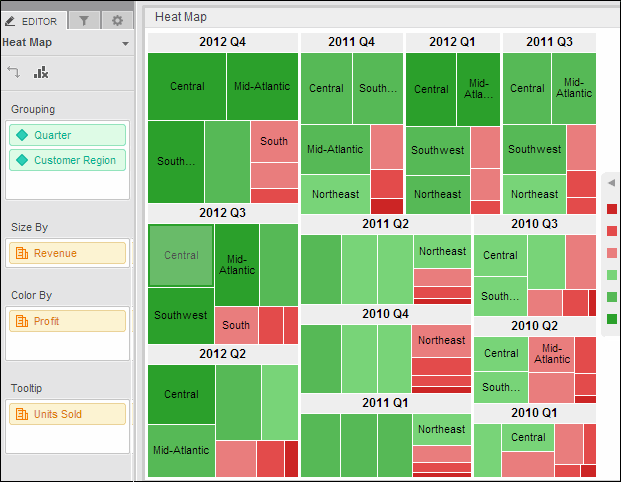Open topic with navigation
Creating a Heat Map visualization
A Heat Map visualization is a combination of colored rectangles, each
representing an attribute element. You can add a Heat Map visualization
to a dashboard
to allow users to quickly grasp the state and impact of a large number
of variables at one time. Heat Maps are often used in the financial services
industry to review the status of a portfolio.
The rectangles contain a wide variety and many shadings of colors, which
emphasize the weight of the various components. In a Heat Map visualization:
- The
size of each rectangle represents its relative weight.
- The
color of each rectangle represents its relative value. For example,
in the image below, larger values are green and smaller values are
red.
- The
large areas, such as the 22 Q4 and 2011 Q4 areas of rectangles in
the image below, represent different groups of data.
- The
small rectangles, such as Central and Mid-Atlantic in the image below,
represent individual attribute elements.

Prerequisites
- You
must have the Web Edit Dashboard and Web Run Dashboard privileges.
- You
must have already created the dashboard to add the visualization to.
Steps to create
and add a Heat Map visualization to a dashboard
- Click the name of the dashboard
to run it.
- From the toolbar, click the Insert Visualization icon
 . A new blank visualization is
added to the dashboard and displayed.
. A new blank visualization is
added to the dashboard and displayed.
- From the Visualization Gallery,
click the Heat Map icon.
- If the Datasets panel is not displayed,
from the View menu, select
Datasets Panel.
- From the Datasets
panel, click and drag attributes to the appropriate area in the Editor panel, as follows. You can
also drag objects from the Datasets panel directly onto the visualization.
- Drag
at least one attribute to the Grouping
area. The elements of the attribute are displayed in the visualization.
For example, if the attribute is Year, a rectangle for each year
is displayed in the visualization.
You can drag additional attributes to the Grouping area to group
the rectangles in the visualization in a larger area. For example,
the Region attribute contains the element South and the Call Center
attribute contains the elements New Orleans and Memphis. If Region
is placed above Call Center in the Grouping area, an area called
South is displayed in the visualization, with the rectangles New
Orleans and Memphis inside. You can add additional attributes
to further group the rectangles in the Heat Map.
- To select
the metric that determines the size of each rectangle, drag the
metric to the Size By
area. Rectangles for large metric values are displayed as larger
than rectangles for small metric values.
- To have
the rectangles colored automatically based on the value of a metric
or based on the elements in an attribute, drag the attribute or
metric to the Color By
area.
Note: If other graphs and
heat maps are colored based on the same attribute, each attribute
value will display in the same color across all the graphs and
heat maps. Numerify360 for IT automatically selects the colors based
on the color palette, but you can select a color for each attribute
value.
-
For each attribute in the Editor
panel, you can select which attribute forms are displayed in the visualization.
An attribute form is a descriptive category for an attribute.
To select the attribute forms, in the Editor panel, right-click the
attribute and point to Display Attribute
Form. Select one of the following:
- To display
an attribute form in the visualization, select the check box next
to its name.
- To hide
an attribute form in the visualization, clear the check box next
to its name.
- To display additional metrics
in a tooltip when a user hovers the cursor over a rectangle, place
the metrics you want to display on the Tooltip
area.
- Click the Save
icon
 to save your changes.
to save your changes.
 Copyright Numerify, Inc. All Rights Reserved ©2021
Copyright Numerify, Inc. All Rights Reserved ©2021


 Copyright Numerify, Inc. All Rights Reserved ©2021
Copyright Numerify, Inc. All Rights Reserved ©2021